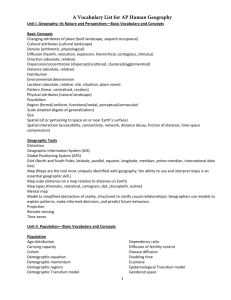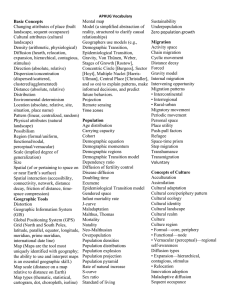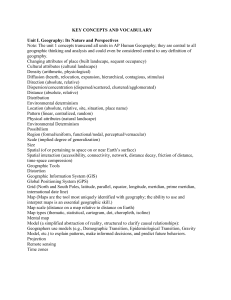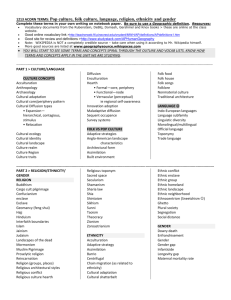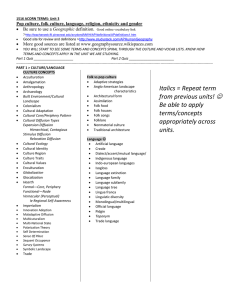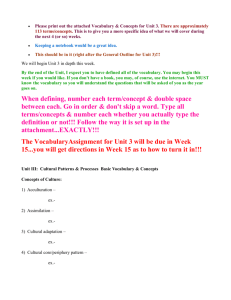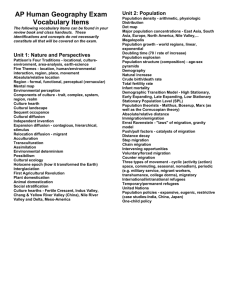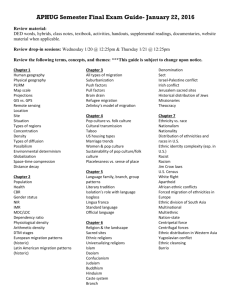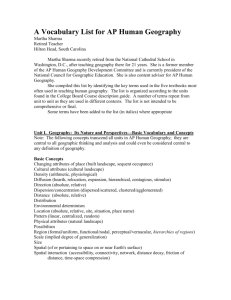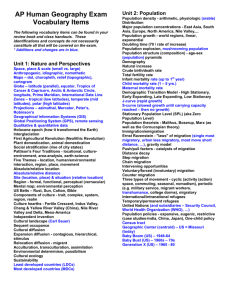AP Human Geography Vocabulary List
advertisement
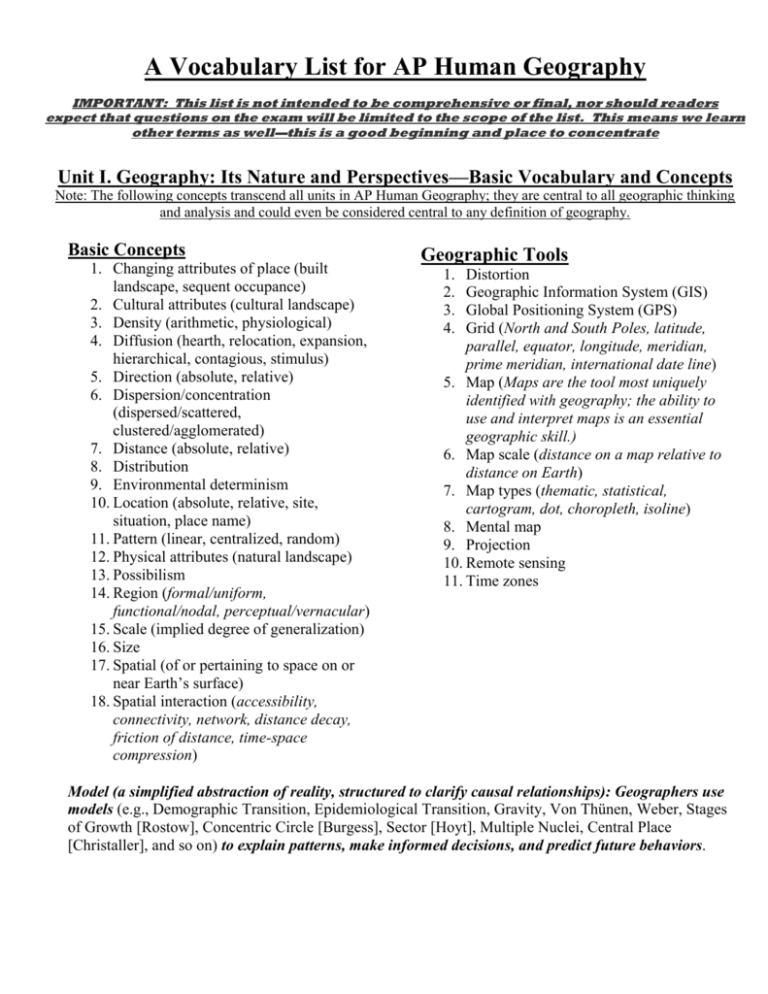
A Vocabulary List for AP Human Geography IMPORTANT: This list is not intended to be comprehensive or final, nor should readers expect that questions on the exam will be limited to the scope of the list. This means we learn other terms as well—this is a good beginning and place to concentrate Unit I. Geography: Its Nature and Perspectives—Basic Vocabulary and Concepts Note: The following concepts transcend all units in AP Human Geography; they are central to all geographic thinking and analysis and could even be considered central to any definition of geography. Basic Concepts 1. Changing attributes of place (built landscape, sequent occupance) 2. Cultural attributes (cultural landscape) 3. Density (arithmetic, physiological) 4. Diffusion (hearth, relocation, expansion, hierarchical, contagious, stimulus) 5. Direction (absolute, relative) 6. Dispersion/concentration (dispersed/scattered, clustered/agglomerated) 7. Distance (absolute, relative) 8. Distribution 9. Environmental determinism 10. Location (absolute, relative, site, situation, place name) 11. Pattern (linear, centralized, random) 12. Physical attributes (natural landscape) 13. Possibilism 14. Region (formal/uniform, functional/nodal, perceptual/vernacular) 15. Scale (implied degree of generalization) 16. Size 17. Spatial (of or pertaining to space on or near Earth’s surface) 18. Spatial interaction (accessibility, connectivity, network, distance decay, friction of distance, time-space compression) Geographic Tools 1. 2. 3. 4. Distortion Geographic Information System (GIS) Global Positioning System (GPS) Grid (North and South Poles, latitude, parallel, equator, longitude, meridian, prime meridian, international date line) 5. Map (Maps are the tool most uniquely identified with geography; the ability to use and interpret maps is an essential geographic skill.) 6. Map scale (distance on a map relative to distance on Earth) 7. Map types (thematic, statistical, cartogram, dot, choropleth, isoline) 8. Mental map 9. Projection 10. Remote sensing 11. Time zones Model (a simplified abstraction of reality, structured to clarify causal relationships): Geographers use models (e.g., Demographic Transition, Epidemiological Transition, Gravity, Von Thünen, Weber, Stages of Growth [Rostow], Concentric Circle [Burgess], Sector [Hoyt], Multiple Nuclei, Central Place [Christaller], and so on) to explain patterns, make informed decisions, and predict future behaviors. Unit II. Population—Basic Vocabulary and Concepts Population 1. Age distribution 2. Carrying capacity 3. Cohort 4. Demographic equation 5. Demographic momentum 6. Demographic regions 7. Demographic Transition model 8. Dependency ratio 9. Diffusion of fertility control 10. Disease diffusion 11. Doubling time 12. Ecumene 13. Epidemiological Transition model 14. Gendered space 15. Infant mortality rate 16. J-curve 17. Maladaptation 18. Malthus, Thomas 19. Mortality 20. Natality 21. Neo-Malthusian 22. Overpopulation 23. Population densities 24. Population distributions 25. Population explosion 26. Population projection 27. Population pyramid 28. Rate of natural increase 29. S-curve 30. Sex ratio 31. Standard of living 32. Sustainability 33. Underpopulation 34. Zero population growth Migration 1. 2. 3. 4. 5. 6. 7. 8. 9. Activity space Chain migration Cyclic movement Distance decay Forced Gravity model Internal migration Intervening opportunity Migration patterns • Intercontinental • Interregional • Rural-urban 10. Migratory movement 11. Periodic movement 12. Personal space 13. Place utility 14. Push-pull factors 15. Refugee 16. Space-time prism 17. Step migration 18. Transhumance 19. Transmigration 20. Voluntary Unit III. Cultural Patterns and Processes, Part 1—Basic Vocabulary and Concepts Concepts of Culture 1. Acculturation 2. Assimilation 3. Cultural adaptation 4. Cultural core/periphery pattern 5. Cultural ecology 6. Cultural identity 7. Cultural landscape 8. Cultural realm 9. Culture 10. Culture region • Formal—core, periphery • Functional—node • Vernacular (perceptual)— regional self-awareness 11. Diffusion types • Expansion—hierarchical, contagious, stimulus • Relocation 12. Innovation adoption 13. Maladaptive diffusion 14. Sequent occupance Folk and Popular Culture 1. Adaptive strategies 2. Anglo-American landscape characteristics 3. Architectural form 4. Built environment 5. Folk culture 6. Folk food 7. Folk house 8. Folk songs 9. Folklore 10. Material culture 11. Nonmaterial culture 12. Popular culture 13. Survey systems 14. Traditional architecture Language 1. Creole 2. Dialect 3. Indo-European languages 4. Isogloss 5. Language 6. Language family 7. Language group 8. Language subfamily 9. Lingua franca 10. Linguistic diversity 11. Monolingual/multilingual 12. Official language 13. Pidgin 14. Toponymy 15. Trade language Unit III. Cultural Patterns and Processes, Part 2—Basic Vocabulary and Concepts Religion 1. Animism 2. Buddhism 3. Cargo cult pilgrimage 4. Christianity 5. Confucianism 6. Ethnic religion 7. Exclave/enclave 8. Fundamentalism 9. Geomancy (feng shui) 10. Hadj 11. Hinduism 12. Interfaith boundaries 13. Islam 14. Jainism 15. Judaism 16. Landscapes of the dead 17. Monotheism/polytheism 18. Mormonism 19. Muslim pilgrimage 20. Muslim population 21. Proselytic religion 22. Reincarnation 23. Religion (groups, places) 24. Religious architectural styles 25. Religious conflict 26. Religious culture hearth 27. Religious toponym 28. Sacred space 29. Secularism 30. Shamanism 31. Sharia law 32. Shintoism 33. Sikhism 34. Sunni/Shia 35. Taoism 36. Theocracy 37. Universalizing 38. Zoroastrianism Ethnicity 1. Acculturation 2. Adaptive strategy 3. Assimilation 4. Barrio 5. Chain migration 6. Cultural adaptation 7. Cultural shatterbelt 8. Ethnic cleansing 9. Ethnic conflict 10. Ethnic enclave 11. Ethnic group 12. Ethnic homeland 13. Ethnic landscape 14. Ethnic neighborhood 15. Ethnicity 16. Ethnocentrism 17. Ghetto 18. Plural society 19. Race 20. Segregation 21. Social distance Gender 1. 2. 3. 4. 5. 6. Dowry death Enfranchisement Gender Gender gap Infanticide Longevity gap 7. Maternal mortality rate
